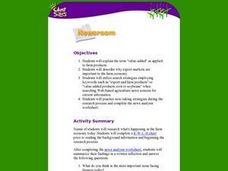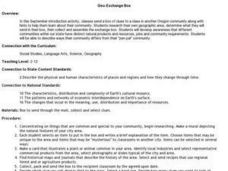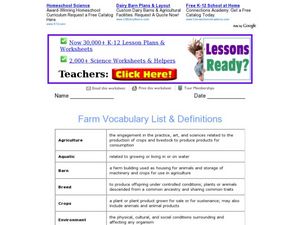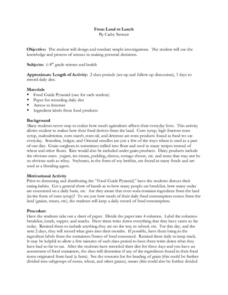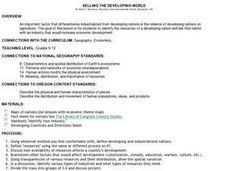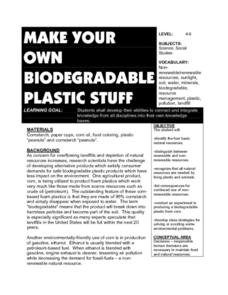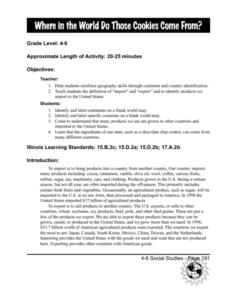Curated OER
The History of Ethanol in America
Sixth graders explore and examine the production of biofuels from the 1850's to the present. Included in their research is Henry Ford, ethanol, World War I and prohibition. They explain the importance of grains and grasses for the...
Curated OER
Newsroom
Students use the Internet and graphic organizers to organize the information they collect about farm products and exports.
Curated OER
Geo-Exchange Box
Students send a box of clues to a class in another Oregon community along with hints to help them study about their community. Students research their own geographic area, determine what they send in their box, then collect and assemble...
Curated OER
Farming in a Fishbowl: How Ethnic Groups in
Seventh graders research Chinese agricultural needs and practices. They conduct an experiment with aquaculture and germinated rice as they take measurements and apply the scientific method.
Curated OER
Farm Vocabulary List and Definitions
In this farm vocabulary worksheet, students learn 15 words pertaining to farming, agriculture and farm animals. Students read definitions for each word. There are no questions to answer.
Curated OER
CALORIE COUNTDOWN
Students will categorize foods according to their components and energy content.1. Design a large bulletin board with sections for carbohydrates, fats and proteins.
2. Ask students to bring labels and packages of different food products....
Curated OER
Cows, Worms, and Compost
Students study decomposition. In this decomposition instructional activity, students discuss the background information about decomposition. Students then complete the 'Chew It Twice' worksheet.
Curated OER
Prune Boom
Students explore the process of harvesting and canning prunes. They discover the benefits of prunes to the Santa Clara Valley. Students investigate prunes at designated websites.
Curated OER
From Land to Lunch
Students record their three meals and snacks for three days. They determine which items in their diets are grown on farms and record the items in various categories. They conduct Internet research to determine where carious ingredients...
Curated OER
Selling the Developing World
Learners compare and contrast the industrialized nations with the developing ones. In groups, they link a developing country with a industrialized one that could increase its economic development. They present their findings to the class...
Curated OER
Examining What Sharing Really Means
Learners read "The Senegalese Miracle". They discuss the amount of sharing the author finds in Africa. They examine the relationship the author has to the locals.
Curated OER
Causes of America's Great Depression
Students identify principal causes of the Great Depression. They analyze causes including a decline in worldwide trade, the stock market crash, and bank failures and explain the legacy of the Depression in American society.
Curated OER
Make Your Own Biodegradable Plastic Stuff
Students identify the four basic natural resources. They distinguish bettween renewable and non-renewable resources. Pupils recognize that all natural resources are needed by living plants and animals. Students list consequences for...
Balanced Assessment
County Concerns
Apply area concepts to help farmers and settle county disputes. Scholars use a given diagram and information about an insecticide spraying campaign to determine the monetary benefit to farmers. They then decide which of two counties has...
Curated OER
The Origin of Humans
Where did human beings come from? How did they settle into communities and civilizations? Your class will find the answers in this fascinating presentation, which takes the viewer through the stages of mankind, from the primitive...
Facts and Files
The Nile
While it may not be possible to take an entire class to Egypt and explore the ancient wonders, it is possible to engage your young historians in activities that ask them to research these and other antiquities and place them on their...
Curated OER
Where it Grows
First graders identify the commodities of Oregon and produce a map of the different commodities in different regions.
Curated OER
Where in the World Do Those Cookies Come From?
Students discuss exports and imports by discovering where the ingredients come from for making chocolate chip cookies. They take a survey of their favorite cookies and create a bar graph to represent the information.
Curated OER
An International Dinner Table
Students investigate the origins of several crops eaten in the United States today. The facto0rs that influence consumer choices and the influences on the American population as to eating preferences are discussed in this lesson.
Curated OER
Foods
Students identify what types of items are grown on a farm. They discuss how those items are processed and turned into food they everyday. They are to write a paragraph using transition words.
Curated OER
Imports and Exports for Making a Food Pyramid
Students examine the food pyramid and discuss it nutritional value. They play a game to determine what types of foods and number of servings they need to complete food pyramids. they can i"import" or "export" cards with foods they need...
Curated OER
Examining What Sharing Really Means
After reading "The Senegalese Miracle" about the degree of sharing the author encounters upon arrival in Africa, class members read Mike Tidwell’s “Sharing in Africa” and compare the two stories. This cultural diversity lesson plan...
Curated OER
The Beagle Brigade
Students develop an understanding of animal behaviors through reading a case study about detector beagles. They explore the interaction of innate abilities and learned behaviors.
Curated OER
Farmers - Caretakers of the Land
Students explore resource management, specifically farming. After reviewing vocabulary words, groups of students explore what is conserved by each practice. They compare and contrast responses. Students describe farming procedures which...

